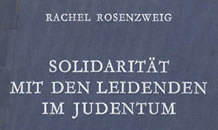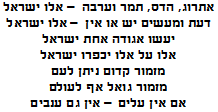| The
Purpose of HEALING - K.I.S.S.
- as stated 12 years ago - was and is
to help me and my potential P E E R s
"to HEAL ourselves into WHOLEness,
and - by extension - all of CREATion!" |
|
I focus my experiencing and awareness on being
"a pioneer of Evolution in
learning to feel":
I let my Body vibrate and my Heart 'womb'
pain, shame, fear, boredom, powerlessness,
so feelings can >heal >guide>fulfill>evolve,
and ~~~ offer ~~~"goldmines"~~~ to us all!!
"I
want you to feel everything, every little thing!"
|
|
Re-edited
on July 23, 2013 ----------- In
this research - first completed 41 years ago -
I cannot update, how the central concept of "SIN" has to be radically
transmuted.
Sin is "Suende" in German, which derives from "sondern"=
to separate.
The actual "Suende" is "Denial", i.e. the separation between
Thinking and Feeling,
i.e. the lack of awareness - by ignoring, overriding, repressing -
of what I do not want in my life - a) feelings, b) needs, c) qualities, d)
greatness.
These denied parts of myself do not simply disappear ,
but survive in body and soul and all around me,
they even attract more of the same denials, become monstrous,
produce evil doing, perpetration, or evil suffering, victimhood.
The redemption from "Sin", i.e. from denial and "Lost Will"-
and from there the redemption from suffering and death,
begins with learning to feel, i.e. to accept, "to womb" what I feel,
to move it physically and then to understand...
In other words: I can allow myself to feel unpleasant feelings, needs, qualities,
only if I KNOW and PRACTISE - that every feeling, from the tiniest to the
biggest -
must be V I B R A T E D , i.e. physically breathed, sounded,
moved,
in order to heal and evolve, and then fulfill its task: to guide me and to
full-fill me.
Once there was a quantum-leap in evolution,
when humans understood that there was a connection between suffering and doing.
Since they knew from the beginning (unlike humankind today), that the many
and the one were tied together,
their "solution" then was, to uproot the one evil-doer from the
community, so as to spare it the consequences.
The next quantum-leap in evolution, was,
when it was understood that this "solution" caused even more suffering,
and they evolved the idea of "reproach and protest".
This, also, caused more damage than benefit.
The "solution" people then came up with, was not an evolution, but
a re-volution:
it was to deny the connection between doing and suffering altogether
and to ignore the mutual guarantorship between the one and the many.
As the present time-period shows, this was/is a horrendous denial,
yes the culmination of an absurd, monstrous illusion.
Now the time has come, to go down to the deepest roots of both:
the connection between doing/notdoing (=denial) and suffering,
and the connection between me, the individual, and everybody else .
Maryam
or Christa-Rachêl Bat-Adâm, ex-married Rachêl Rosenzweig,
born in Germany 1938,
living at Arad & at
Bet-Nehemya, Israel, PH.D.1972,
Grandma
of 10 ~~CONTACT
HOME  GOD
HAS EVOLVED
GOD
HAS EVOLVED ED.
GODCHANNEL
ED.
GODCHANNEL MY
LIFE'S HARVEST
MY
LIFE'S HARVEST
 Moving-Evolving
Emotions
Moving-Evolving
Emotions  Noah's
Vision
Noah's
Vision AUschwitz-BirkenAU
AUschwitz-BirkenAU Bat-Sheva&David
Bat-Sheva&David
 |
My PH.D.-Thesis, 1966-1982, University 1972
Original Theme,1966 : The Idea of VICARIOUS
SUFFERING as an ANSWER to INNOCENT SUFFERING
(i.e. my coping with the holocaust).
Final Hebrew Title 1972: "The PERCEPTION
of SUFFERING and SOLIDARITY
with the SUFFERERS
in the Thought of the Jewish Sages from the time of the second Commonwealth
till the End of the Talmudic Era"
(i.e. in Bible, Apocryphes, Qumran, New Testament, Talmud, Midrash)
|
|
See
the overview of "MY BOOK" in the context of "MY LIFE's
HARVEST"
 |
"All
Israel are Guarantors for Each Other"
Maryam, alias Christa-Rachel Bat-Adam,
married Rachel Rosenzweig, born Eva-Maria-Christa Guth
|
|
| Etrog,
Myrtle, Date, and Willow
-- these are Israel!
Knowing and doing do exist or do not
-- these are Israel!
They shall make one union - Israel!
They will atone for each other -Israel!
An ancient psalm was given to the nation!
A redeeming psalm also for the World!
Without leaves- there won't be grapes!
|
|
|
|
English Summary and English Digests
continuation
of Rafael Rosenzweig's translation of the original summary
of the PH.D. thesis delivered to the Jerusalem University on Purim 1972
DIGEST - SECOND PART,
SOLIDARITY WITH THE SUFFERER Chapters 1-3
An
Introductory Midrash
II.1 God's Solidarity
II.2 Examples of Solidarity
in the Bible
[The Levite's
Concubine and Esther, the King's Concubine]
II.3 The Sages' formulated
thought on solidarity
An
Introductory Midrash:
"The prisoner does not free himself"
II.1
God's Solidarity
Clarifying comment: Solidarity and its connection
with the general rules of life.
The purpose of the second part is
to go deeper into the problem of scope and nature of identification in times
of stress,
between the individual and the community as well as between man and his fellow.
A description of the solidary God
comes before the description of solidary man,
for the theological formulation of an anthropological requirement
emphasizes the importance of this requirement
- the demand for solidarity -
within the set values of national philosophy.
His identification with the suffering appears to be an unique characteristic
of Israel's God,
right from his first appearance to Moses,
and it is contained in the very "etymology" according to which the
name JHWH is explained in the Torah.
Through this solidarity, JHWH grants both security and consolation,
but he does not take from the nation or from man
their responsibility for their actions and omissions.
To this character of "JHWH", as
it was created by Moses,
a great deal of influcence must be accorded in the philosophy of consolation
which appeared after the destruction of the second temple.
A good number of tales (Midrashim)
emphasize the solidarity of God or his Shekhina (Divine Presence in female gender)
with the nation in its sorrow.
They do so, either assisted by the symbol of the thorny bush,
chosen by God for his appearance,
or based upon two classic sentences in the Bible,
and also with daring parables.
The humanity of God, who feels the nations' pain as if he himself were suffering,
consoles Israel and sheds light into their "Valley of the Shadow of Death".
[2008_05_29 - I discovered, that II.2
is either missing
or included in the first chapter.
I cannot put this right now, but I'll refer to the German and Hebrew pages and
the titles:
bundle
14]
Second Chapter
Guarantorship-Solidarity-Responsibility
1. The difference between
divine and human solidarity
2. "No prisoner releases himself from prison"
3. The Law of Life
II.3
Examples of Solidarity in the Bible
[The Levite's
Concubine and Esther, the King's Concubine]
It is difficult to isolate "Solidarity"
from its connections with the laws of life,
meaning from its roots
(the mutual guarantorship between individual and community, and between man
and his fellow)
and from its fruits
(the responsibility between individual and community and between man and his
fellow).
However, it is necessary to isolate "Solidarity" for better understanding
of its nature.
The two biblical stories, chosen to show
what solidarity is,
relate all the connection of guarantorship, solidarity and responsibility,
sophisticated as they are.
Nevertheless, in both of them solidary bevavior in times of trouble stands out
as the principal purpose.
It is this very purpose that characterizes theses tales as parables.
The tale about the Levite's concubine teaches the solidarity of the community
with the individual,
and be it the lowest and the least significant one.
On the other hand, the tale of the King's concubine teaches about the individual's
solidarity with the community,
be the individual a despised one, and actually very far from being able to play
this role.
Both tales - one of them among the most ancient, the other amongst the latest
in the Bible - prove,
how very important was solidarity as a pattern for practical behavior and as
an ethical requirement,
from the very beginnings of Israel's history.
II.4
The Sages' formulated thought on solidarity
1. "Don't segregate from the community!" the individuals's solidarity
with the community
2. "You know the stranger's soul": solidarity of man and his fellow
3. "One is afflicted and all suffer": The community's solidarity with
the sorrowing individual
The application of solidarity with the sufferers
touches on three kinds of human relationships:
the relations between the individual and the community,
that between man and his fellow
and finally the relationship between the community and the individual.
While the opinions of the sages can hardly be contained in such a scheme,
since they did not equally deal with the three areas,
a scientific approach necessitates the differentiation.
A polished and well explained theory was
developed by the sages
regarding the solidarity of the individual with the community.
This is not strange, since we have already noted in the first part,
that the community's suffering was very much a part of the sages' consciousness
- much more so than the suffering of man or the suffering of the next fellow
in particular.
It would be, however, a big mistake
to deduce from the importance given by the sages to the community,
that they disregarded the individual.
The opposite is true:
because the sages recognized the individual's power to harm the community,
they also knew about his potential to benefit it.
The Law of Mutual Guarantorship forces man into solidarity with his community,
and the feeling of solidarity forces man into responsibility towards the community.
Both, value and power of the individual are, therefore,
a result of the Law of Mutual Guarantorship.
Probably, the deepest thinker on this subject was "Eliyahu the Preacher".
This logic also explains, why it is necessary
to deal separately
with the solidarity of outstanding personalities with their community.
Although every individual should consider himself to be "a potential Abraham",
there are outstanding characters who realize this aim in practice.
The solidarity between man and his fellow
also was expressed as an ethical order,
and even as a base for all "ethical" behaviour of man towards his
fellow.
Many evidences from the philosophers of Israel,
beginning with Ecclesiastes, through Jesus of Nazareth
and ending with whom tradition thought to be a unique authority - R. Aqiba -
discerned the importance of this secular base for all ethics.
Not love for the fellow man was required,
but identification with him,
the recognition of the fact that your fellow is like you,
suffers as you suffer,
sins as you sin.
Love can be only one of the many applications of the feeling of identification.
The Bible often makes those that were typical
sufferers of the time
like foreigners, slaves, widows and orphans,
the model for the motivation towards this "ethical" behaviour.
Israel's historical memory plays a vital part in the learning
of how to identify with the sufferer in particular and with the fellow in general.
On the other hand, the sages did not very often enlarge their discussions on
these models.
Here, a strange contradiction is apparent;
on the one hand, the sages succeeded in abstracting the biblical principle
and in emphasizing the basic power of the solidarity between man and his fellow
as an ethical motivation.
On the other hand - the framework of commandments which was constructed at the
very same time,
practically discounted the principle.
Only in an extreme situation, when facing death,
it appears that the motivation "Thy fellow is as you
are"
serves as a base for action.
Behaviour of man and his fellow in the face of danger
has to form the proof of that "great rule in the Torah",
that identification is a vital demand.
"Your blood is not more red than your fellow's"
shouted Raba,
unlike R. Aqiba, who in his statement "Your life is
more important than your fellow's"
left the teaching of solidarity of the Bible and of the sages as well.
The philosophy of the
sages also dealt with the problem of the community's solidarity with the individual,
however not as an ethical demand but as a fact,
forming a necessary result of the community's dependance upon the individual
according to the Law of Mutual Guarantorship.
The philosophy in this respect is even more general and theoretical
than in respect to solidarity between man and his fellow.
What does it mean - "One is afflicted - and all
feel it?"
How can this "feeling" be translated into action?
A number of answers to this questions may be found in connection with the sinning
individual,
but not regarding the suffering individual.
The complex of the sinning individual will be discussed in the fifth chapter.
![]() GOD
HAS EVOLVED
GOD
HAS EVOLVED![]() ED.
GODCHANNEL
ED.
GODCHANNEL![]() MY
LIFE'S HARVEST
MY
LIFE'S HARVEST
![]() Moving-Evolving
Emotions
Moving-Evolving
Emotions ![]() Noah's
Vision
Noah's
Vision![]() AUschwitz-BirkenAU
AUschwitz-BirkenAU![]() Bat-Sheva&David
Bat-Sheva&David


